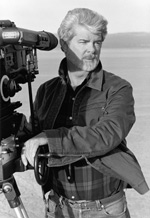TEC Awards Hall of Fame 2004 Inductee
George Lucas

George Lucas's devotion to timeless storytelling
and cutting-edge innovation has resulted in some of the most successful and
beloved films of all time. In making them, Lucas has also pushed the envelope
of technology, not only in image and sound creation, but also in the way that
audiences everywhere enjoy the film going experience.
In 1971, working with San Francisco production studio American Zoetrope and
longtime friend Francis Ford Coppola as executive producer, Lucas transformed
an award-winning student film into his first feature, THX 1138. His
second feature film, the low-budget American Graffiti (1973), became
the most successful film of its time, and garnered Golden Globe, New York
Film Critics' and National Society of Film Critics' awards. Pushing the boundaries
of storytelling, American Graffiti was the first film of its kind to
tell multiple stories through interweaving narratives backed by a soundtrack
of contemporary music. And rather than simply appearing from nowhere, all
of the classic tunes creating the film's backbone are played via onscreen
sources—another cinema first.
It was Lucas's third film, 1977's Star Wars, that changed everything.
Refusing to accept the limitations of filmmaking at the time, Lucas created
his own visual effects company, Industrial Light & Magic, to make his
vision a reality. Star Wars set new standards for sophistication in
film visuals and won eight Academy Awards; at the same time, its impact on
film sound was profound. At a time when the industry was moving toward electronic
scores, Star Wars revived the popularity of the large symphonic score,
while the film's success jumpstarted the fledgling Dolby Stereo optical 4-channel
format, leading to thousands of theaters worldwide upgrading to multichannel
surround sound systems.
The Lucas magic continued with The Empire Strikes Back in 1980 and
Return of the Jedi in 1983. In the 1980s, he co-wrote and executive-produced
the successful Raiders of the Lost Ark, Indiana Jones and the Temple
of Doom and 1989's Indiana Jones and the Last Crusade, a trilogy
that won eight Academy Awards. Later, The Young Indiana Jones Chronicles
used ILM technology to create effects and historical locales that could otherwise
have never been done on the budget of a television series. It won 12 Emmy
Awards in the process.
In 1983, Lucas founded THX Ltd. to provide technology and performance standards
to ensure that the vision of filmmakers and musical artists is accurately
presented to cinema, home entertainment and automotive consumer audiences.
THX® Certification is considered a mark of excellence in the entertainment
industry. For consumers, it represents a promise that the cinemas they visit
and the products they purchase meet the highest standards for picture and
sound performance.
Lucasfilm and its audio division, Skywalker Sound, have applied their own
technical expertise to the crafting of a film's soundtrack and post-production
editing. Innovations such as SoundDroid and EditDroid were the forerunners
of tools that are now considered standard in post-production. In 1984, SoundDroid
was a spellbinding technological achievement, offering picture interlock,
multitrack recording, sound synthesis, editing, mixing dynamics control, reverb
and effects—all from a touch-sensitive graphics screen, using soft keys,
assignable knobs and moving faders. These pioneering computer-based nonlinear
picture and audio post technologies became the basis for preferred editing
platforms used in film and television today.
The "firsts" continued: In April 1991, Skywalker Sound began using
Dolby AC-2 coding to transmit over T1 lines to link the Marin County facility
to locations worldwide, fundamentally changing the logistics for ADR and mixing.
In 1997, Skywalker Sound collaborated with THX and Dolby to create a new center-rear
surround channel for film sound mixing. The resulting 6.1 Digital Surround
EX system premiered with Star Wars: Episode I The Phantom Menace in
1999, and forever changed the sonic experience in the movie theater. Today,
years of research and development in the areas of fiber networking and state-of-the-art
digital audio environments, make Skywalker the most dynamic audio post facility
in the world.
Lucas expanded Lucasfilm Ltd. to encompass a number of major divisions. ILM
continues to grow, delivering visual effects for scores of films, TV specials
and commercials. In 1985, ILM developed the first digital creature for Young
Sherlock Holmes and in 1988 debuted the "morphing" effect for
Willow. ILM continued breaking new ground with the liquid-metal killer
in Terminator 2, and the lifelike dinosaurs of Jurassic Park.
The computer graphic research division of Lucasfilm was spun-off in 1986 and
became Pixar Animation Studios. Other Lucasfilm branches include LucasArts
Entertainment Company, a leading developer of computer and console-based entertainment,
which revolutionized the industry with its patented iMUSE Interactive Music
Streaming Engine, bringing new levels of audio realism to the games industry.
Lucas is currently in post-production on the third and final prequel, Star
Wars: Episode III Revenge of the Sith, which is scheduled to be released
May 19, 2005.
Lucas continues to invest in Lucasfilm divisions such as ILM and Skywalker
Sound and in the Letterman Digital Arts Center, a new 23-acre production complex
that will start operating in 2005 in San Francisco's Presidio. George Lucas
has said that "sound is 50 percent of the motion picture experience,"
and with his lifelong commitment to creating and preserving the highest standards
of audio (and picture, too) he has not only shaped the production industry,
but also the entertainment experiences of uncountable people worldwide. DOWNLOAD
THIS TEXT